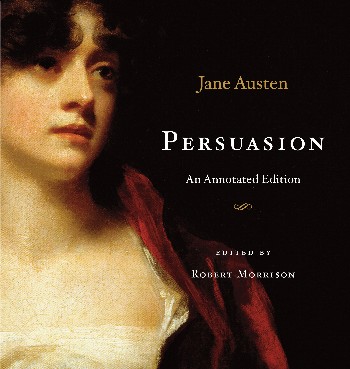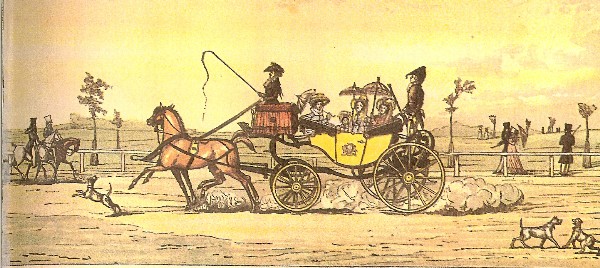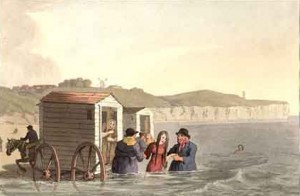Book Review: Annotating Jane — An Illuminating New Edition of Austen’s Persuasion
This invaluable addition to the Austen literature offers two for the price of one: a beautifully designed and printed edition of the novel many consider her best and a parallel critical commentary that deepens our understanding and opens up a rich, textured view of her world and time.
Persuasion: An Annotated Edition by Jane Austen. Edited by Robert Morrison. The Belknap Press of Harvard University Press, 360 pages, 102 color ills., $35.
By Evelyn Rosenthal
What is it about Jane Austen? A seemingly endless appetite for her characters and their stories has spawned multiple film and television adaptations. Now contemporary writers are even grafting horror and mystery fiction heads onto her novels’ proper, Regency bodies—see Pride and Prejudice and Zombies (soon to be a probably minor motion picture) and P. D. James’s current bestseller Death at Pemberley (Elizabeth Bennet as Nancy Drew?). All this dressing up of her work in new clothes—whether elegant BBC and Hollywood productions or flashy pop lit—points to the timelessness of the mix of romance, humor, and skewering of pretensions found in the novels of Austen, who completed only six in her too-short life.
For Janeites who have come to the end of her oeuvre and aren’t content to settle for pop reimaginings, the best way to get an Austen fix has been to reread. The one that I really can’t go too long without picking up again is her last completed novel, Persuasion. This story of rueful second chances centers on Anne Elliot who, at 27, is well on her way to spinsterhood. Eight years after the “persuasion” of a family friend induced her to break her engagement to Frederick Wentworth, a promising but not yet “independent” (i.e., rich) naval captain, she has lost her “bloom.” Although every rereading ends with Anne getting her captain—and her bloom—back, I had never thought about just what losing your “bloom” really meant. It’s easy to gloss over unfamiliar details, terms, and usages when you’re caught up in Austen’s most passionate love story, with its incisive character portraits and keen satire on the niceties and nuances of class distinctions.
I thought I knew this novel well, but reading Robert Morrison’s Persuasion: An Annotated Edition showed me how much more there is to know. An invaluable addition to the Austen literature and to any Austen lover’s bookshelf, this Persuasion offers two for the price of one: a beautifully designed and produced hardcover edition of the novel that many consider her best (a belief I share with Morrison) and a parallel critical commentary that deepens our understanding and opens up a rich, textured view of her world and time.
The setting is southwestern England in the summer of 1814, and the melancholy, subdued Anne is a heroine after Austen’s own heart: a reader and an observer, with “an elegance of mind and sweetness of character, which must have placed her high with any people of real understanding.” These, unfortunately, do not include her vain and snobbish father, Sir Walter, and eldest sister, Elizabeth, for whom she is “nobody.” Living above his means, Sir Walter is forced to “retrench” and lease out their estate, Kellynch Hall, to one Admiral Croft and his wife, who happens to be the sister of Anne’s lost love. While Sir Walter and Elizabeth move to the seaside resort town of Bath, Anne goes to stay with her youngest sister, Mary, at the nearby estate of the Musgroves, whose son Charles is Mary’s husband. Captain Wentworth, back from sea duty (now, as Morrison tells us, that Napoleon has been exiled to Elba) and staying with his sister, visits the Musgrove clan and reenters Anne’s life.
After their first, awkward encounter, the clueless Mary tells Anne that Wentworth has found her “so altered he should not have known you again.” No more “bloom”—a word that, to me, had always conjured up pale cheeks and faded beauty. But Morrison, citing Amy King, author of an entire book on the concept of “bloom” in English novels, explains that in Austen’s day the term had “connotations of courtship and sexual attractiveness.” Anne wasn’t just looking a little wan; she had basically lost her place in the marriage market—a disaster for a woman of her time and class, who would eventually lose her home to her father’s closest male heir, a cousin.
In his superb introduction, and in the many annotations accompanying the text, Morrison fills out the wider picture of the world within which Anne and Wentworth’s romance plays out. We learn about Napoleonic naval battles and the commanders who, like Wentworth, made their fortune in “prize money” gained from capturing enemy ships. A dinner conversation at the Musgroves prompts notes on life and conditions in the Royal Navy and the importance of the West Indies to the British economy (and a reminder from Edward Said that even though Austen didn’t, we might ponder “possible responses by the Caribbean or Indian natives resident there”).
Austen hints at Anne’s suitability for Wentworth by contrasting her knowledge of all things naval with the ignorance of Henrietta and Louisa, the two Musgrove daughters vying for Wentworth’s affections. Our own ignorance is relieved by notes explaining the different types of ships (sloops, frigates, three-deckers) and the relative prestige of their commands. What Wentworth describes as a “lovely cruise . . . off the Western Islands” turns out to be no balmy pleasure outing but a lucrative “raiding expedition in pursuit of plunder” off the Azores. We also discover that Austen’s brother Francis had done that very “cruise” in 1812—and that, just as Anne’s admiration for and knowledge of the navy grew out of her attachment to Wentworth, Austen’s came from her own brothers, two of whom had successful naval careers.
While there is another annotated Persuasion by David M. Shapard—a paperback with about 60 black-and-white illustrations, published in 2010—this volume differs in a couple of significant ways. For one thing, Morrison judiciously incorporates the work of other Austen experts who argue or agree with or illuminate his own commentary, adding scholarly depth.
And then there are the splendid full-color illustrations. The 102 reproductions of prints, drawings, paintings, books, and maps bring an immediacy to the story and flesh out the notations. Included are illustrations from nineteenth-century editions of the novel; maritime landscapes and naval battles by Turner and other artists of the time; portraits of Austen and her family, and of Lord Byron, Walter Scott, Mary Wollstonecraft, Frances (Fanny) Burney, and other literary figures Austen admired, or that Anne and the narrator mention; and views and maps of Lyme Regis, where a crucial outing takes place, and Bath, where most of the book’s second half is set. Austen tells us exactly where in Bath various characters are staying, but it’s Morrison who explains the social significance of who lives where. Here and throughout the volume, he helps us recover layers of characterization and meaning that modern readers would otherwise miss. For example, Anne’s genial brother-in-law, Charles, drives a jaunty two-seat curricle, “the Regency equivalent of a sports car,” and the pompous Lady Dalrymple gads about in a barouche, the Rolls Royce of carriages. And when Austen mentions “bathing machines” in her detailed and evocative description of Lyme, an engraving shows exactly how they worked—a cabin on wheels is rolled into the sea and the bather emerges, fully clothed, for a dip—and gives a clear picture of the absurd (to us) lengths to which bathers would go to preserve modesty.
My only quibble about the illustrations is that once in a while a figure appears on a page before or several pages after the annotation that refers to it, and I sometimes found myself hunting through the text for its context. A simple note number reference in the caption would help here, and I hope the publisher will consider this for the forthcoming annotated editions of the rest of Austen’s works in this series that began with Pride and Prejudice, edited by Patricia Meyer Spacks, in 2010.
![JanePortrait3_thumb[1]](https://artsfuse.org/wp-content/uploads/2012/02/JanePortrait3_thumb1.jpg)
Unfinished sketch of Austen by her sister Cassandra, c. 1811—the only known authentic likeness of the author.
Finally, Morrison includes Austen’s brother Henry’s charming biographical introduction, which was included in the novel’s first edition, published in December 1817 as a set with Northanger Abbey. Here he announced her death (in July of that year) and revealed her identity as the author of Pride and Prejudice, Emma, Mansfield Park, and Sense and Sensibility (published anonymously). He also quotes the famous letter Austen wrote to a nephew in which she deprecates her own work as “a little bit of ivory, two inches wide, on which I work with a brush so fine as to produce little effect after much labour.” By the time we read this well-known quote, Morrison has convinced us that any view of Austen’s world as a narrow one of marriage plots and social relations among the gentry does not apply—at least, not to Persuasion.
—————————————————–
For those who can’t get enough Persuasion, there have been two excellent, BBC adaptations in recent years. My favorite is the 1995 film by Roger Michell, starring Amanda Root as Anne Elliot and Ciarán Hinds as Captain Wentworth, with Corin Redgrave as the cold and snobbish Sir Walter and Sophie Thompson (sister of Emma) as Anne’s whiny sister Mary. A 2007 production starred Sally Hawkins as Anne and Rupert Penry-Jones as Wentworth. Both were filmed on location in Lyme and Bath. There is also an avid Persuasion fanbase that has generated a multitude of home-made YouTube videos, setting scenes from the films to music. Here’s a good one of the 1995 film.
Tagged: Harvard University Press, Jane Austen, Persuasion: An Annotated Edition





Thank you for this–I just added it to my library list.
But I disagree that there has ever been a good adaptation of this book.
The only worthwhile Austen film is Emma Thompson’s Sense and Sensibility.
You’re welcome, and I hope you enjoy it as much as I did. I guess we differ on the adaptation question, though. I really thought the 1995 version was excellent. The 2007 one I saw but don’t remember very clearly. Of course, Sense and Sensibility, adapted by Emma Thompson, is wonderful. I also rather like the BBC version of Emma, with Romola Garai.